Second Language Acquisition Report: Learning Styles Analysis
VerifiedAdded on 2021/06/15
|14
|3571
|93
Report
AI Summary
This report provides an in-depth analysis of second language acquisition (SLA), examining the influence of learning styles and individual differences on the language learning process. The report begins with an introduction to SLA, defining it as the process of acquiring an additional language after the first language has been mastered. It then explores various factors that influence SLA, including the role of the first language (L1), motivation, age, and cognitive styles. The report presents a literature review of relevant research and theories in SLA, including the impact of L1 interference, the critical period hypothesis, and the importance of learner motivation. The study includes a case study of a Pakistani student in Australia, using interview data to explore their experiences with English as a second language, learning strategies, and motivations. The findings highlight the significance of interactive teaching methods, peer tutoring, and goal-oriented learning environments in promoting effective SLA. The report concludes with a discussion of the results and their implications for language teaching and learning, emphasizing the need for educators to consider individual learning styles and create motivating learning environments.
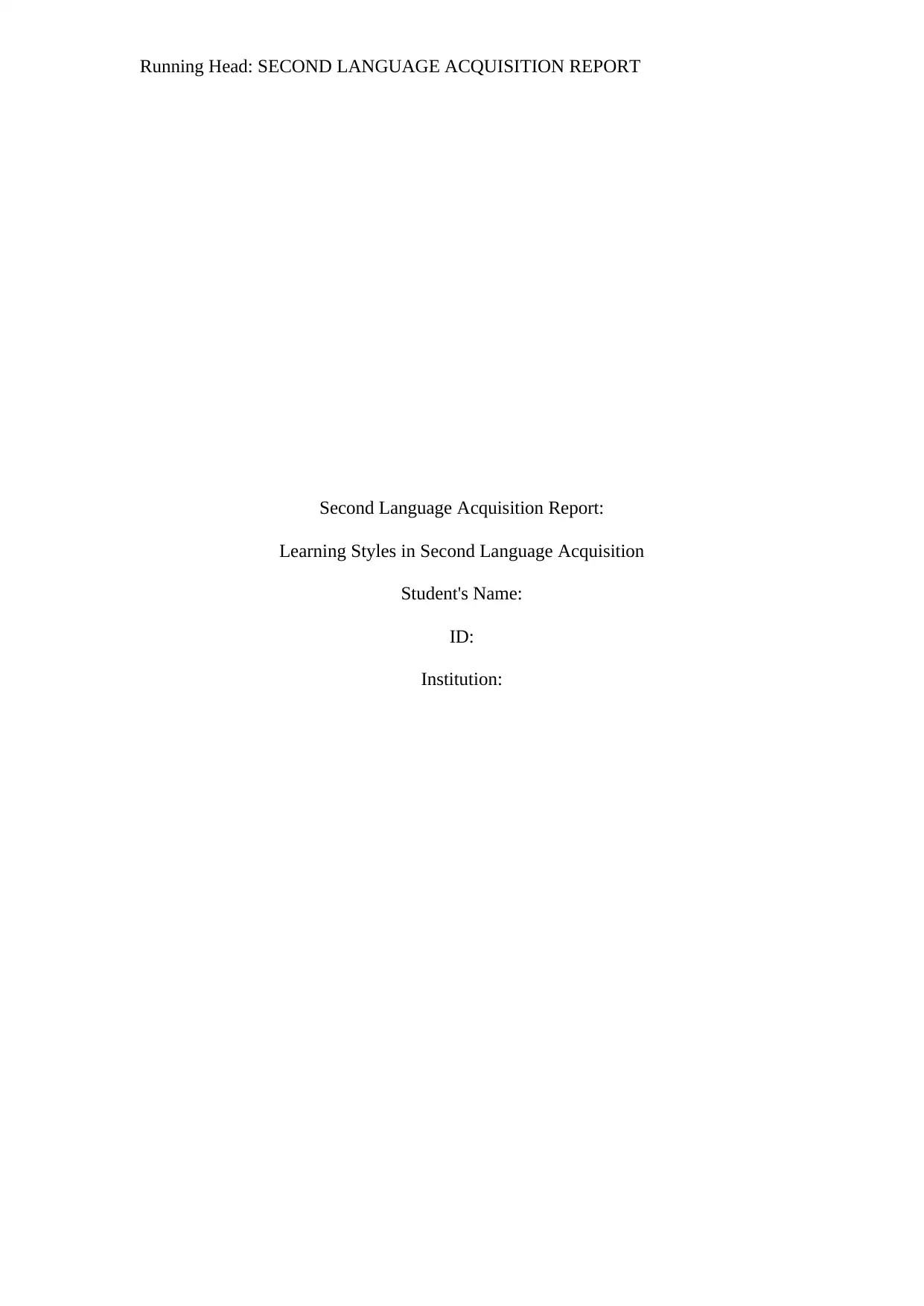
Running Head: SECOND LANGUAGE ACQUISITION REPORT
Second Language Acquisition Report:
Learning Styles in Second Language Acquisition
Student's Name:
ID:
Institution:
Second Language Acquisition Report:
Learning Styles in Second Language Acquisition
Student's Name:
ID:
Institution:
Paraphrase This Document
Need a fresh take? Get an instant paraphrase of this document with our AI Paraphraser
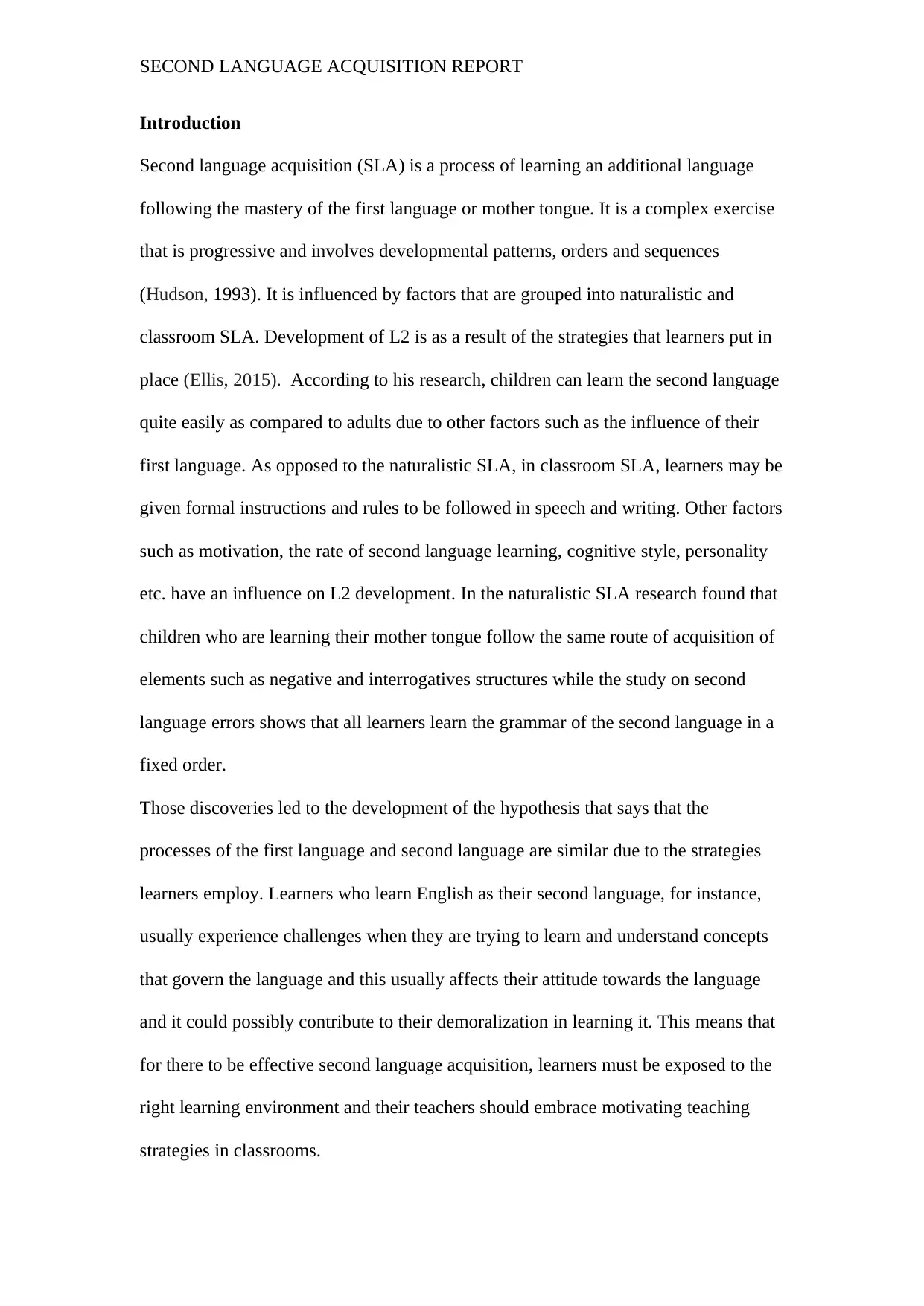
SECOND LANGUAGE ACQUISITION REPORT
Introduction
Second language acquisition (SLA) is a process of learning an additional language
following the mastery of the first language or mother tongue. It is a complex exercise
that is progressive and involves developmental patterns, orders and sequences
(Hudson, 1993). It is influenced by factors that are grouped into naturalistic and
classroom SLA. Development of L2 is as a result of the strategies that learners put in
place (Ellis, 2015). According to his research, children can learn the second language
quite easily as compared to adults due to other factors such as the influence of their
first language. As opposed to the naturalistic SLA, in classroom SLA, learners may be
given formal instructions and rules to be followed in speech and writing. Other factors
such as motivation, the rate of second language learning, cognitive style, personality
etc. have an influence on L2 development. In the naturalistic SLA research found that
children who are learning their mother tongue follow the same route of acquisition of
elements such as negative and interrogatives structures while the study on second
language errors shows that all learners learn the grammar of the second language in a
fixed order.
Those discoveries led to the development of the hypothesis that says that the
processes of the first language and second language are similar due to the strategies
learners employ. Learners who learn English as their second language, for instance,
usually experience challenges when they are trying to learn and understand concepts
that govern the language and this usually affects their attitude towards the language
and it could possibly contribute to their demoralization in learning it. This means that
for there to be effective second language acquisition, learners must be exposed to the
right learning environment and their teachers should embrace motivating teaching
strategies in classrooms.
Introduction
Second language acquisition (SLA) is a process of learning an additional language
following the mastery of the first language or mother tongue. It is a complex exercise
that is progressive and involves developmental patterns, orders and sequences
(Hudson, 1993). It is influenced by factors that are grouped into naturalistic and
classroom SLA. Development of L2 is as a result of the strategies that learners put in
place (Ellis, 2015). According to his research, children can learn the second language
quite easily as compared to adults due to other factors such as the influence of their
first language. As opposed to the naturalistic SLA, in classroom SLA, learners may be
given formal instructions and rules to be followed in speech and writing. Other factors
such as motivation, the rate of second language learning, cognitive style, personality
etc. have an influence on L2 development. In the naturalistic SLA research found that
children who are learning their mother tongue follow the same route of acquisition of
elements such as negative and interrogatives structures while the study on second
language errors shows that all learners learn the grammar of the second language in a
fixed order.
Those discoveries led to the development of the hypothesis that says that the
processes of the first language and second language are similar due to the strategies
learners employ. Learners who learn English as their second language, for instance,
usually experience challenges when they are trying to learn and understand concepts
that govern the language and this usually affects their attitude towards the language
and it could possibly contribute to their demoralization in learning it. This means that
for there to be effective second language acquisition, learners must be exposed to the
right learning environment and their teachers should embrace motivating teaching
strategies in classrooms.
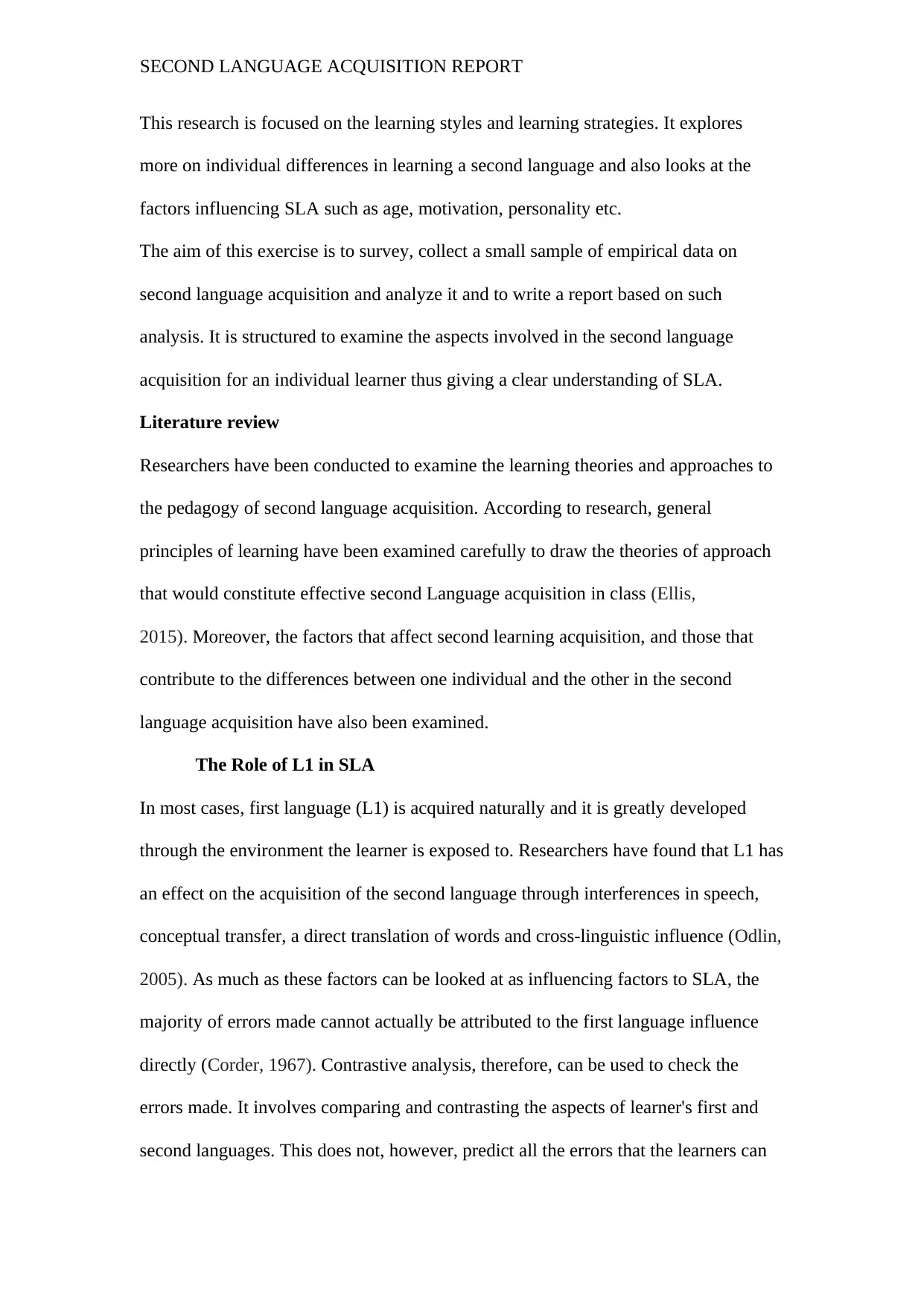
SECOND LANGUAGE ACQUISITION REPORT
This research is focused on the learning styles and learning strategies. It explores
more on individual differences in learning a second language and also looks at the
factors influencing SLA such as age, motivation, personality etc.
The aim of this exercise is to survey, collect a small sample of empirical data on
second language acquisition and analyze it and to write a report based on such
analysis. It is structured to examine the aspects involved in the second language
acquisition for an individual learner thus giving a clear understanding of SLA.
Literature review
Researchers have been conducted to examine the learning theories and approaches to
the pedagogy of second language acquisition. According to research, general
principles of learning have been examined carefully to draw the theories of approach
that would constitute effective second Language acquisition in class (Ellis,
2015). Moreover, the factors that affect second learning acquisition, and those that
contribute to the differences between one individual and the other in the second
language acquisition have also been examined.
The Role of L1 in SLA
In most cases, first language (L1) is acquired naturally and it is greatly developed
through the environment the learner is exposed to. Researchers have found that L1 has
an effect on the acquisition of the second language through interferences in speech,
conceptual transfer, a direct translation of words and cross-linguistic influence (Odlin,
2005). As much as these factors can be looked at as influencing factors to SLA, the
majority of errors made cannot actually be attributed to the first language influence
directly (Corder, 1967). Contrastive analysis, therefore, can be used to check the
errors made. It involves comparing and contrasting the aspects of learner's first and
second languages. This does not, however, predict all the errors that the learners can
This research is focused on the learning styles and learning strategies. It explores
more on individual differences in learning a second language and also looks at the
factors influencing SLA such as age, motivation, personality etc.
The aim of this exercise is to survey, collect a small sample of empirical data on
second language acquisition and analyze it and to write a report based on such
analysis. It is structured to examine the aspects involved in the second language
acquisition for an individual learner thus giving a clear understanding of SLA.
Literature review
Researchers have been conducted to examine the learning theories and approaches to
the pedagogy of second language acquisition. According to research, general
principles of learning have been examined carefully to draw the theories of approach
that would constitute effective second Language acquisition in class (Ellis,
2015). Moreover, the factors that affect second learning acquisition, and those that
contribute to the differences between one individual and the other in the second
language acquisition have also been examined.
The Role of L1 in SLA
In most cases, first language (L1) is acquired naturally and it is greatly developed
through the environment the learner is exposed to. Researchers have found that L1 has
an effect on the acquisition of the second language through interferences in speech,
conceptual transfer, a direct translation of words and cross-linguistic influence (Odlin,
2005). As much as these factors can be looked at as influencing factors to SLA, the
majority of errors made cannot actually be attributed to the first language influence
directly (Corder, 1967). Contrastive analysis, therefore, can be used to check the
errors made. It involves comparing and contrasting the aspects of learner's first and
second languages. This does not, however, predict all the errors that the learners can
⊘ This is a preview!⊘
Do you want full access?
Subscribe today to unlock all pages.

Trusted by 1+ million students worldwide

SECOND LANGUAGE ACQUISITION REPORT
make and thus it is not an effective tool since it is based on hypothesis and predictions
(Ferris, D. 2002). Recently, it has been discovered that learners transfer linguistic
elements from their first language into the second language. These elements are said
to be unmarked if they are more basic or core or usual while others are said to be
marked if they are special or peripheral or unusual (James, 2013). Learners tend to
transfer unmarked elements and resist marked forms. Leaners also draw their intuition
from how close or distance their L1 is from L2 in term psychotypology or
psychological distance.
Learners Differences in SLA
The differences between learners in the second language acquisition are contributed
by many factors some of which are discussed below:
Motivation
Learners' motivation and needs are key in the development of L2. Learners who get
interested in the social and cultural norms of the native speakers of the language they
are learning are likely to have effective L2 acquisition (Dörnyei, 2001). This can also
apply to learners who are learning the foreign language to achieve certain specific
objectives such as for study purposes. Conversely, learners who are less concerned
with the affairs of the native speakers of the language they are learning and have no
particular instrumental of mastery of the language will have a hard task in learning.
The Age Factor
Age is considered to be a major factor in SLA. It is viewed that the brains of learners
at an early age are able to information with ease as compared to learners at a late age.
Children are believed to have greater memory and can be focus more easily or form
features of a language. However, examination of critical period hypothesis shows that
there is a period where when language acquisition takes place naturally and with less
make and thus it is not an effective tool since it is based on hypothesis and predictions
(Ferris, D. 2002). Recently, it has been discovered that learners transfer linguistic
elements from their first language into the second language. These elements are said
to be unmarked if they are more basic or core or usual while others are said to be
marked if they are special or peripheral or unusual (James, 2013). Learners tend to
transfer unmarked elements and resist marked forms. Leaners also draw their intuition
from how close or distance their L1 is from L2 in term psychotypology or
psychological distance.
Learners Differences in SLA
The differences between learners in the second language acquisition are contributed
by many factors some of which are discussed below:
Motivation
Learners' motivation and needs are key in the development of L2. Learners who get
interested in the social and cultural norms of the native speakers of the language they
are learning are likely to have effective L2 acquisition (Dörnyei, 2001). This can also
apply to learners who are learning the foreign language to achieve certain specific
objectives such as for study purposes. Conversely, learners who are less concerned
with the affairs of the native speakers of the language they are learning and have no
particular instrumental of mastery of the language will have a hard task in learning.
The Age Factor
Age is considered to be a major factor in SLA. It is viewed that the brains of learners
at an early age are able to information with ease as compared to learners at a late age.
Children are believed to have greater memory and can be focus more easily or form
features of a language. However, examination of critical period hypothesis shows that
there is a period where when language acquisition takes place naturally and with less
Paraphrase This Document
Need a fresh take? Get an instant paraphrase of this document with our AI Paraphraser
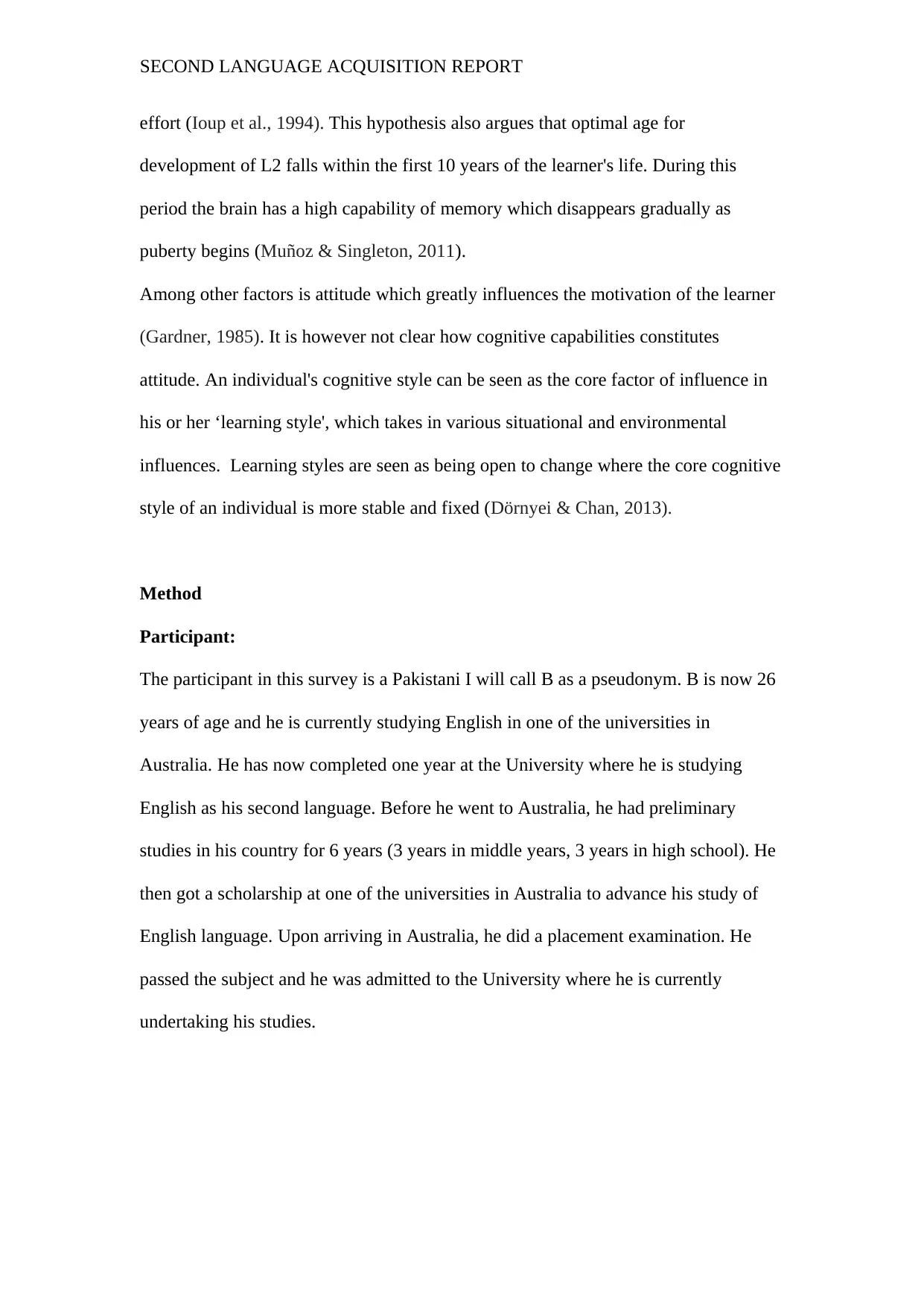
SECOND LANGUAGE ACQUISITION REPORT
effort (Ioup et al., 1994). This hypothesis also argues that optimal age for
development of L2 falls within the first 10 years of the learner's life. During this
period the brain has a high capability of memory which disappears gradually as
puberty begins (Muñoz & Singleton, 2011).
Among other factors is attitude which greatly influences the motivation of the learner
(Gardner, 1985). It is however not clear how cognitive capabilities constitutes
attitude. An individual's cognitive style can be seen as the core factor of influence in
his or her ‘learning style', which takes in various situational and environmental
influences. Learning styles are seen as being open to change where the core cognitive
style of an individual is more stable and fixed (Dörnyei & Chan, 2013).
Method
Participant:
The participant in this survey is a Pakistani I will call B as a pseudonym. B is now 26
years of age and he is currently studying English in one of the universities in
Australia. He has now completed one year at the University where he is studying
English as his second language. Before he went to Australia, he had preliminary
studies in his country for 6 years (3 years in middle years, 3 years in high school). He
then got a scholarship at one of the universities in Australia to advance his study of
English language. Upon arriving in Australia, he did a placement examination. He
passed the subject and he was admitted to the University where he is currently
undertaking his studies.
effort (Ioup et al., 1994). This hypothesis also argues that optimal age for
development of L2 falls within the first 10 years of the learner's life. During this
period the brain has a high capability of memory which disappears gradually as
puberty begins (Muñoz & Singleton, 2011).
Among other factors is attitude which greatly influences the motivation of the learner
(Gardner, 1985). It is however not clear how cognitive capabilities constitutes
attitude. An individual's cognitive style can be seen as the core factor of influence in
his or her ‘learning style', which takes in various situational and environmental
influences. Learning styles are seen as being open to change where the core cognitive
style of an individual is more stable and fixed (Dörnyei & Chan, 2013).
Method
Participant:
The participant in this survey is a Pakistani I will call B as a pseudonym. B is now 26
years of age and he is currently studying English in one of the universities in
Australia. He has now completed one year at the University where he is studying
English as his second language. Before he went to Australia, he had preliminary
studies in his country for 6 years (3 years in middle years, 3 years in high school). He
then got a scholarship at one of the universities in Australia to advance his study of
English language. Upon arriving in Australia, he did a placement examination. He
passed the subject and he was admitted to the University where he is currently
undertaking his studies.
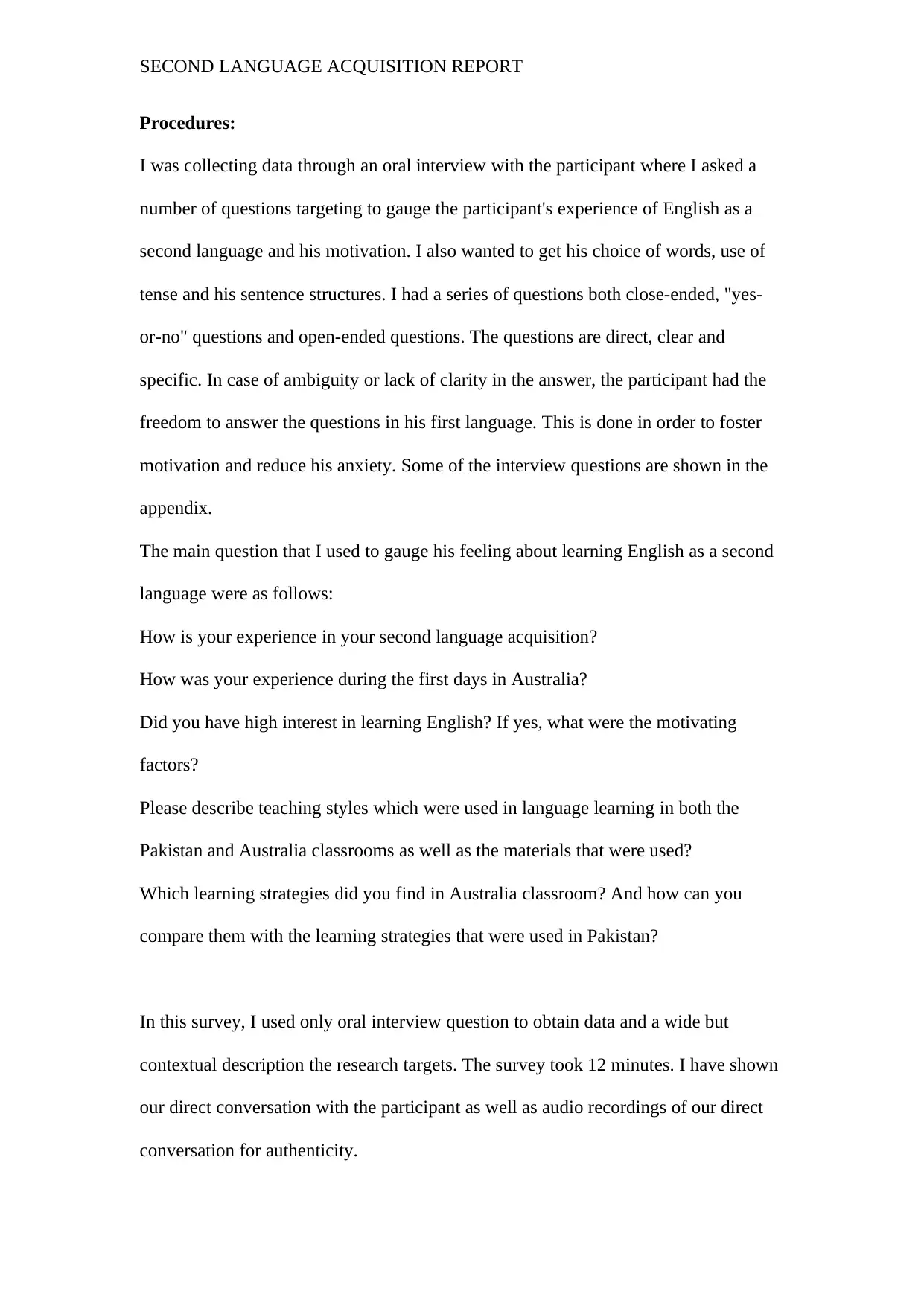
SECOND LANGUAGE ACQUISITION REPORT
Procedures:
I was collecting data through an oral interview with the participant where I asked a
number of questions targeting to gauge the participant's experience of English as a
second language and his motivation. I also wanted to get his choice of words, use of
tense and his sentence structures. I had a series of questions both close-ended, "yes-
or-no" questions and open-ended questions. The questions are direct, clear and
specific. In case of ambiguity or lack of clarity in the answer, the participant had the
freedom to answer the questions in his first language. This is done in order to foster
motivation and reduce his anxiety. Some of the interview questions are shown in the
appendix.
The main question that I used to gauge his feeling about learning English as a second
language were as follows:
How is your experience in your second language acquisition?
How was your experience during the first days in Australia?
Did you have high interest in learning English? If yes, what were the motivating
factors?
Please describe teaching styles which were used in language learning in both the
Pakistan and Australia classrooms as well as the materials that were used?
Which learning strategies did you find in Australia classroom? And how can you
compare them with the learning strategies that were used in Pakistan?
In this survey, I used only oral interview question to obtain data and a wide but
contextual description the research targets. The survey took 12 minutes. I have shown
our direct conversation with the participant as well as audio recordings of our direct
conversation for authenticity.
Procedures:
I was collecting data through an oral interview with the participant where I asked a
number of questions targeting to gauge the participant's experience of English as a
second language and his motivation. I also wanted to get his choice of words, use of
tense and his sentence structures. I had a series of questions both close-ended, "yes-
or-no" questions and open-ended questions. The questions are direct, clear and
specific. In case of ambiguity or lack of clarity in the answer, the participant had the
freedom to answer the questions in his first language. This is done in order to foster
motivation and reduce his anxiety. Some of the interview questions are shown in the
appendix.
The main question that I used to gauge his feeling about learning English as a second
language were as follows:
How is your experience in your second language acquisition?
How was your experience during the first days in Australia?
Did you have high interest in learning English? If yes, what were the motivating
factors?
Please describe teaching styles which were used in language learning in both the
Pakistan and Australia classrooms as well as the materials that were used?
Which learning strategies did you find in Australia classroom? And how can you
compare them with the learning strategies that were used in Pakistan?
In this survey, I used only oral interview question to obtain data and a wide but
contextual description the research targets. The survey took 12 minutes. I have shown
our direct conversation with the participant as well as audio recordings of our direct
conversation for authenticity.
⊘ This is a preview!⊘
Do you want full access?
Subscribe today to unlock all pages.

Trusted by 1+ million students worldwide
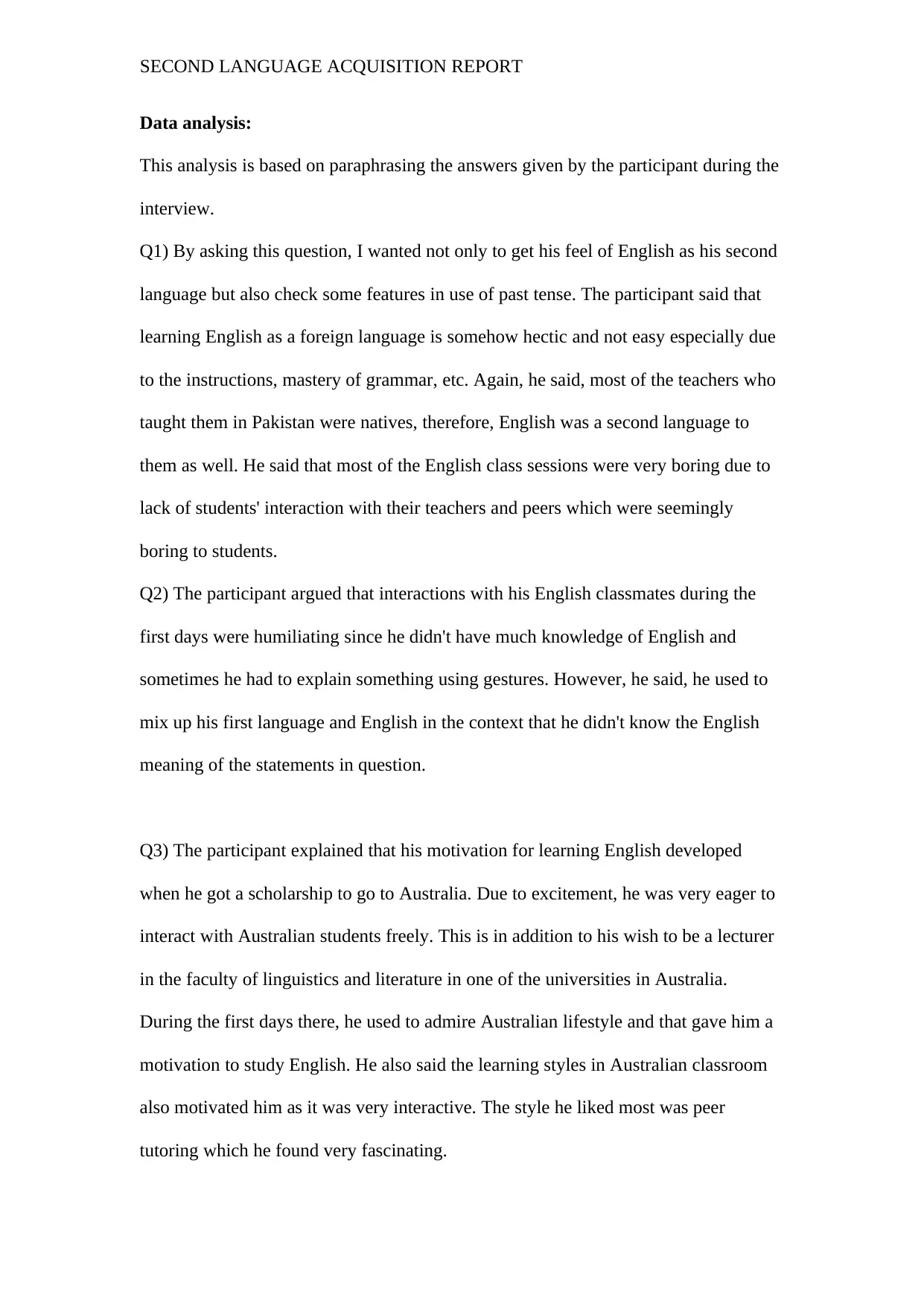
SECOND LANGUAGE ACQUISITION REPORT
Data analysis:
This analysis is based on paraphrasing the answers given by the participant during the
interview.
Q1) By asking this question, I wanted not only to get his feel of English as his second
language but also check some features in use of past tense. The participant said that
learning English as a foreign language is somehow hectic and not easy especially due
to the instructions, mastery of grammar, etc. Again, he said, most of the teachers who
taught them in Pakistan were natives, therefore, English was a second language to
them as well. He said that most of the English class sessions were very boring due to
lack of students' interaction with their teachers and peers which were seemingly
boring to students.
Q2) The participant argued that interactions with his English classmates during the
first days were humiliating since he didn't have much knowledge of English and
sometimes he had to explain something using gestures. However, he said, he used to
mix up his first language and English in the context that he didn't know the English
meaning of the statements in question.
Q3) The participant explained that his motivation for learning English developed
when he got a scholarship to go to Australia. Due to excitement, he was very eager to
interact with Australian students freely. This is in addition to his wish to be a lecturer
in the faculty of linguistics and literature in one of the universities in Australia.
During the first days there, he used to admire Australian lifestyle and that gave him a
motivation to study English. He also said the learning styles in Australian classroom
also motivated him as it was very interactive. The style he liked most was peer
tutoring which he found very fascinating.
Data analysis:
This analysis is based on paraphrasing the answers given by the participant during the
interview.
Q1) By asking this question, I wanted not only to get his feel of English as his second
language but also check some features in use of past tense. The participant said that
learning English as a foreign language is somehow hectic and not easy especially due
to the instructions, mastery of grammar, etc. Again, he said, most of the teachers who
taught them in Pakistan were natives, therefore, English was a second language to
them as well. He said that most of the English class sessions were very boring due to
lack of students' interaction with their teachers and peers which were seemingly
boring to students.
Q2) The participant argued that interactions with his English classmates during the
first days were humiliating since he didn't have much knowledge of English and
sometimes he had to explain something using gestures. However, he said, he used to
mix up his first language and English in the context that he didn't know the English
meaning of the statements in question.
Q3) The participant explained that his motivation for learning English developed
when he got a scholarship to go to Australia. Due to excitement, he was very eager to
interact with Australian students freely. This is in addition to his wish to be a lecturer
in the faculty of linguistics and literature in one of the universities in Australia.
During the first days there, he used to admire Australian lifestyle and that gave him a
motivation to study English. He also said the learning styles in Australian classroom
also motivated him as it was very interactive. The style he liked most was peer
tutoring which he found very fascinating.
Paraphrase This Document
Need a fresh take? Get an instant paraphrase of this document with our AI Paraphraser
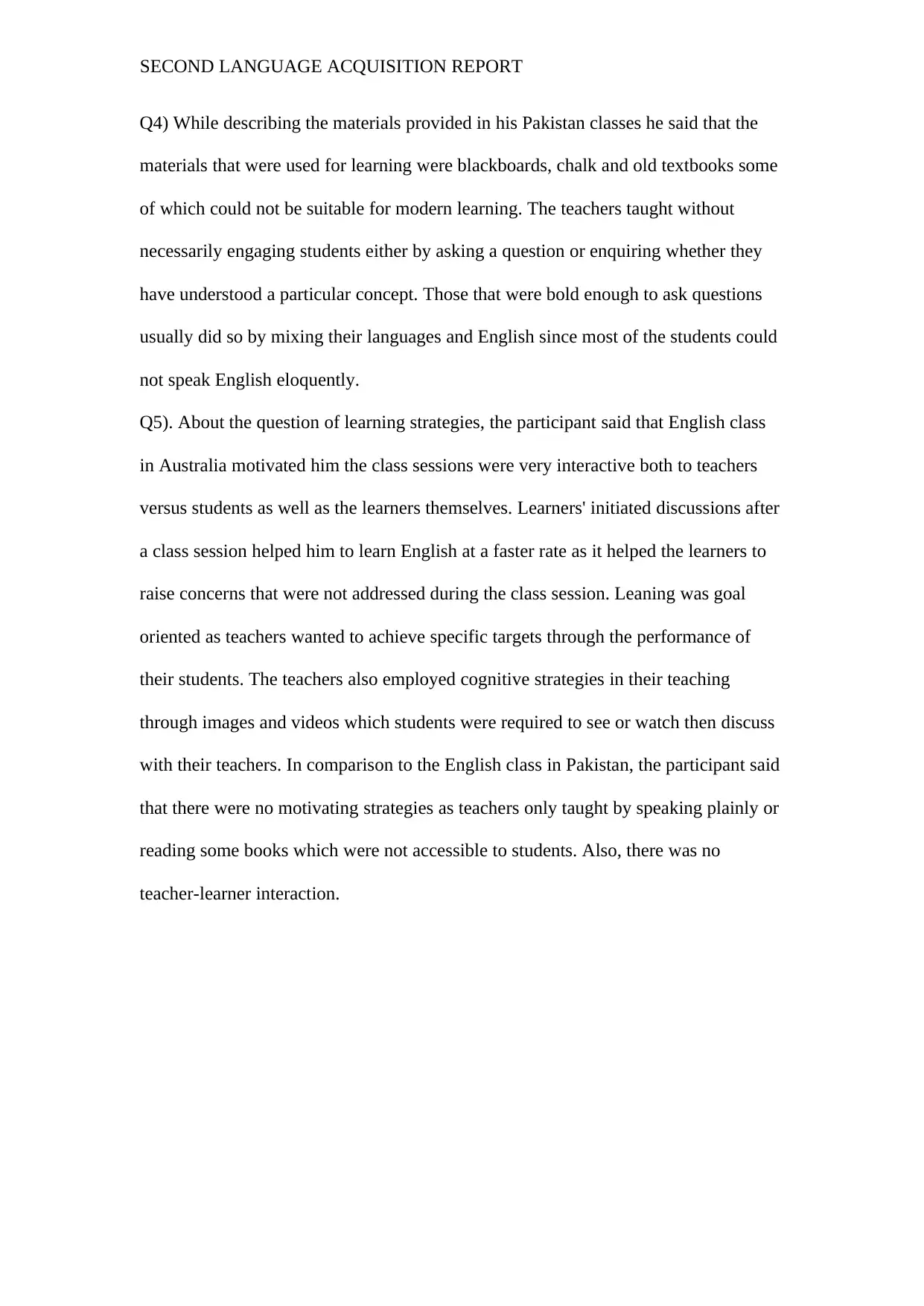
SECOND LANGUAGE ACQUISITION REPORT
Q4) While describing the materials provided in his Pakistan classes he said that the
materials that were used for learning were blackboards, chalk and old textbooks some
of which could not be suitable for modern learning. The teachers taught without
necessarily engaging students either by asking a question or enquiring whether they
have understood a particular concept. Those that were bold enough to ask questions
usually did so by mixing their languages and English since most of the students could
not speak English eloquently.
Q5). About the question of learning strategies, the participant said that English class
in Australia motivated him the class sessions were very interactive both to teachers
versus students as well as the learners themselves. Learners' initiated discussions after
a class session helped him to learn English at a faster rate as it helped the learners to
raise concerns that were not addressed during the class session. Leaning was goal
oriented as teachers wanted to achieve specific targets through the performance of
their students. The teachers also employed cognitive strategies in their teaching
through images and videos which students were required to see or watch then discuss
with their teachers. In comparison to the English class in Pakistan, the participant said
that there were no motivating strategies as teachers only taught by speaking plainly or
reading some books which were not accessible to students. Also, there was no
teacher-learner interaction.
Q4) While describing the materials provided in his Pakistan classes he said that the
materials that were used for learning were blackboards, chalk and old textbooks some
of which could not be suitable for modern learning. The teachers taught without
necessarily engaging students either by asking a question or enquiring whether they
have understood a particular concept. Those that were bold enough to ask questions
usually did so by mixing their languages and English since most of the students could
not speak English eloquently.
Q5). About the question of learning strategies, the participant said that English class
in Australia motivated him the class sessions were very interactive both to teachers
versus students as well as the learners themselves. Learners' initiated discussions after
a class session helped him to learn English at a faster rate as it helped the learners to
raise concerns that were not addressed during the class session. Leaning was goal
oriented as teachers wanted to achieve specific targets through the performance of
their students. The teachers also employed cognitive strategies in their teaching
through images and videos which students were required to see or watch then discuss
with their teachers. In comparison to the English class in Pakistan, the participant said
that there were no motivating strategies as teachers only taught by speaking plainly or
reading some books which were not accessible to students. Also, there was no
teacher-learner interaction.
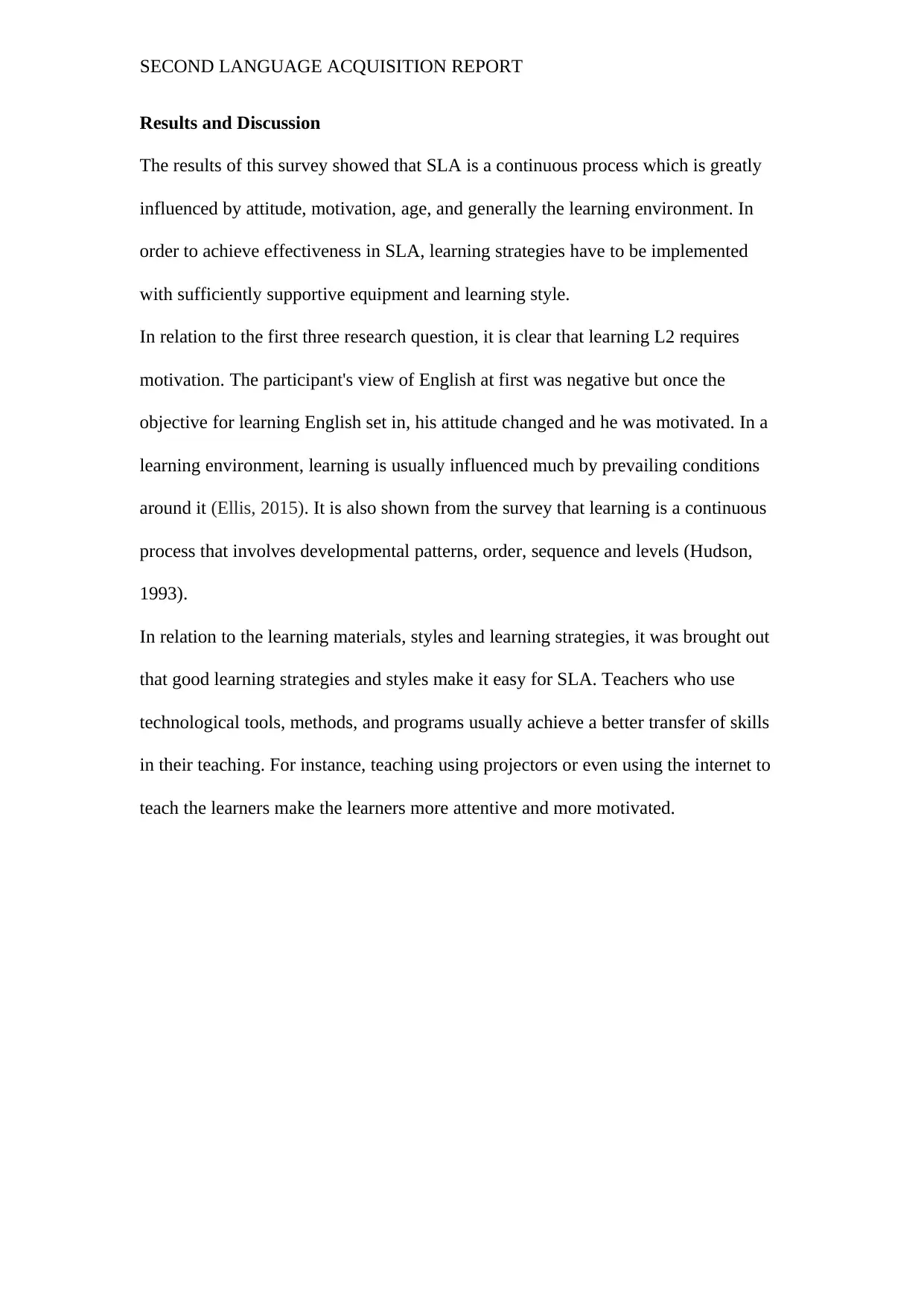
SECOND LANGUAGE ACQUISITION REPORT
Results and Discussion
The results of this survey showed that SLA is a continuous process which is greatly
influenced by attitude, motivation, age, and generally the learning environment. In
order to achieve effectiveness in SLA, learning strategies have to be implemented
with sufficiently supportive equipment and learning style.
In relation to the first three research question, it is clear that learning L2 requires
motivation. The participant's view of English at first was negative but once the
objective for learning English set in, his attitude changed and he was motivated. In a
learning environment, learning is usually influenced much by prevailing conditions
around it (Ellis, 2015). It is also shown from the survey that learning is a continuous
process that involves developmental patterns, order, sequence and levels (Hudson,
1993).
In relation to the learning materials, styles and learning strategies, it was brought out
that good learning strategies and styles make it easy for SLA. Teachers who use
technological tools, methods, and programs usually achieve a better transfer of skills
in their teaching. For instance, teaching using projectors or even using the internet to
teach the learners make the learners more attentive and more motivated.
Results and Discussion
The results of this survey showed that SLA is a continuous process which is greatly
influenced by attitude, motivation, age, and generally the learning environment. In
order to achieve effectiveness in SLA, learning strategies have to be implemented
with sufficiently supportive equipment and learning style.
In relation to the first three research question, it is clear that learning L2 requires
motivation. The participant's view of English at first was negative but once the
objective for learning English set in, his attitude changed and he was motivated. In a
learning environment, learning is usually influenced much by prevailing conditions
around it (Ellis, 2015). It is also shown from the survey that learning is a continuous
process that involves developmental patterns, order, sequence and levels (Hudson,
1993).
In relation to the learning materials, styles and learning strategies, it was brought out
that good learning strategies and styles make it easy for SLA. Teachers who use
technological tools, methods, and programs usually achieve a better transfer of skills
in their teaching. For instance, teaching using projectors or even using the internet to
teach the learners make the learners more attentive and more motivated.
⊘ This is a preview!⊘
Do you want full access?
Subscribe today to unlock all pages.

Trusted by 1+ million students worldwide
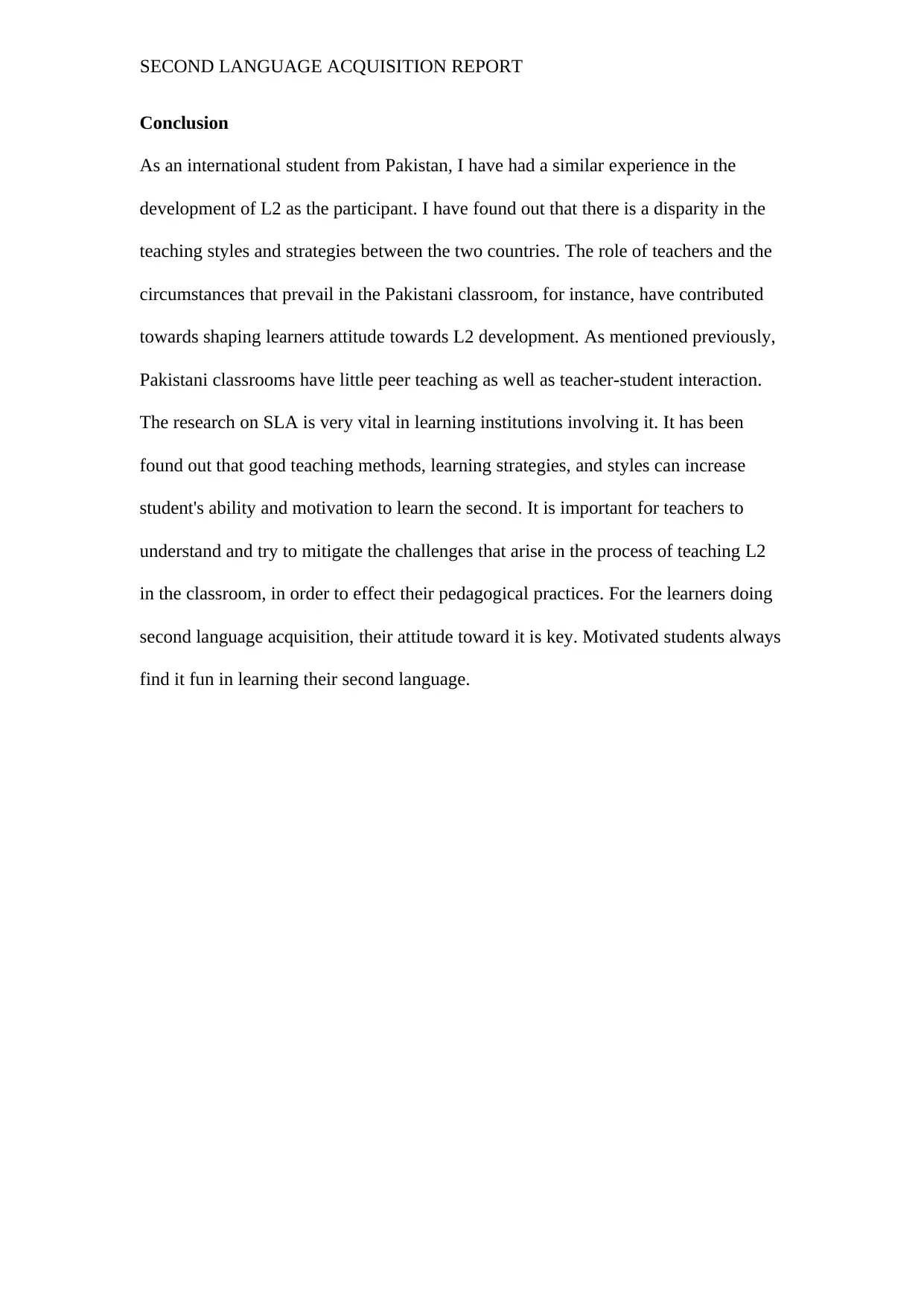
SECOND LANGUAGE ACQUISITION REPORT
Conclusion
As an international student from Pakistan, I have had a similar experience in the
development of L2 as the participant. I have found out that there is a disparity in the
teaching styles and strategies between the two countries. The role of teachers and the
circumstances that prevail in the Pakistani classroom, for instance, have contributed
towards shaping learners attitude towards L2 development. As mentioned previously,
Pakistani classrooms have little peer teaching as well as teacher-student interaction.
The research on SLA is very vital in learning institutions involving it. It has been
found out that good teaching methods, learning strategies, and styles can increase
student's ability and motivation to learn the second. It is important for teachers to
understand and try to mitigate the challenges that arise in the process of teaching L2
in the classroom, in order to effect their pedagogical practices. For the learners doing
second language acquisition, their attitude toward it is key. Motivated students always
find it fun in learning their second language.
Conclusion
As an international student from Pakistan, I have had a similar experience in the
development of L2 as the participant. I have found out that there is a disparity in the
teaching styles and strategies between the two countries. The role of teachers and the
circumstances that prevail in the Pakistani classroom, for instance, have contributed
towards shaping learners attitude towards L2 development. As mentioned previously,
Pakistani classrooms have little peer teaching as well as teacher-student interaction.
The research on SLA is very vital in learning institutions involving it. It has been
found out that good teaching methods, learning strategies, and styles can increase
student's ability and motivation to learn the second. It is important for teachers to
understand and try to mitigate the challenges that arise in the process of teaching L2
in the classroom, in order to effect their pedagogical practices. For the learners doing
second language acquisition, their attitude toward it is key. Motivated students always
find it fun in learning their second language.
Paraphrase This Document
Need a fresh take? Get an instant paraphrase of this document with our AI Paraphraser
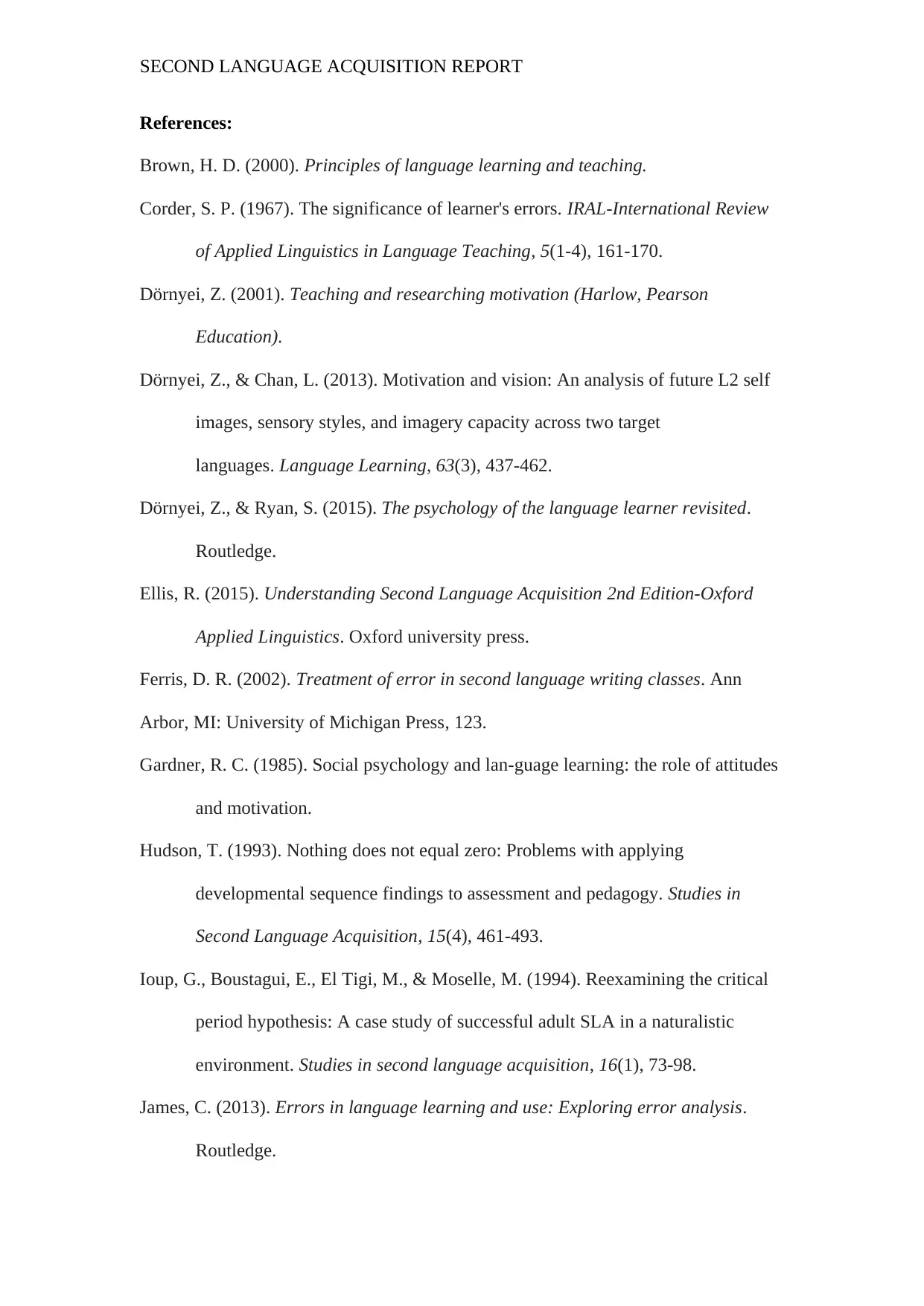
SECOND LANGUAGE ACQUISITION REPORT
References:
Brown, H. D. (2000). Principles of language learning and teaching.
Corder, S. P. (1967). The significance of learner's errors. IRAL-International Review
of Applied Linguistics in Language Teaching, 5(1-4), 161-170.
Dörnyei, Z. (2001). Teaching and researching motivation (Harlow, Pearson
Education).
Dörnyei, Z., & Chan, L. (2013). Motivation and vision: An analysis of future L2 self
images, sensory styles, and imagery capacity across two target
languages. Language Learning, 63(3), 437-462.
Dörnyei, Z., & Ryan, S. (2015). The psychology of the language learner revisited.
Routledge.
Ellis, R. (2015). Understanding Second Language Acquisition 2nd Edition-Oxford
Applied Linguistics. Oxford university press.
Ferris, D. R. (2002). Treatment of error in second language writing classes. Ann
Arbor, MI: University of Michigan Press, 123.
Gardner, R. C. (1985). Social psychology and lan-guage learning: the role of attitudes
and motivation.
Hudson, T. (1993). Nothing does not equal zero: Problems with applying
developmental sequence findings to assessment and pedagogy. Studies in
Second Language Acquisition, 15(4), 461-493.
Ioup, G., Boustagui, E., El Tigi, M., & Moselle, M. (1994). Reexamining the critical
period hypothesis: A case study of successful adult SLA in a naturalistic
environment. Studies in second language acquisition, 16(1), 73-98.
James, C. (2013). Errors in language learning and use: Exploring error analysis.
Routledge.
References:
Brown, H. D. (2000). Principles of language learning and teaching.
Corder, S. P. (1967). The significance of learner's errors. IRAL-International Review
of Applied Linguistics in Language Teaching, 5(1-4), 161-170.
Dörnyei, Z. (2001). Teaching and researching motivation (Harlow, Pearson
Education).
Dörnyei, Z., & Chan, L. (2013). Motivation and vision: An analysis of future L2 self
images, sensory styles, and imagery capacity across two target
languages. Language Learning, 63(3), 437-462.
Dörnyei, Z., & Ryan, S. (2015). The psychology of the language learner revisited.
Routledge.
Ellis, R. (2015). Understanding Second Language Acquisition 2nd Edition-Oxford
Applied Linguistics. Oxford university press.
Ferris, D. R. (2002). Treatment of error in second language writing classes. Ann
Arbor, MI: University of Michigan Press, 123.
Gardner, R. C. (1985). Social psychology and lan-guage learning: the role of attitudes
and motivation.
Hudson, T. (1993). Nothing does not equal zero: Problems with applying
developmental sequence findings to assessment and pedagogy. Studies in
Second Language Acquisition, 15(4), 461-493.
Ioup, G., Boustagui, E., El Tigi, M., & Moselle, M. (1994). Reexamining the critical
period hypothesis: A case study of successful adult SLA in a naturalistic
environment. Studies in second language acquisition, 16(1), 73-98.
James, C. (2013). Errors in language learning and use: Exploring error analysis.
Routledge.
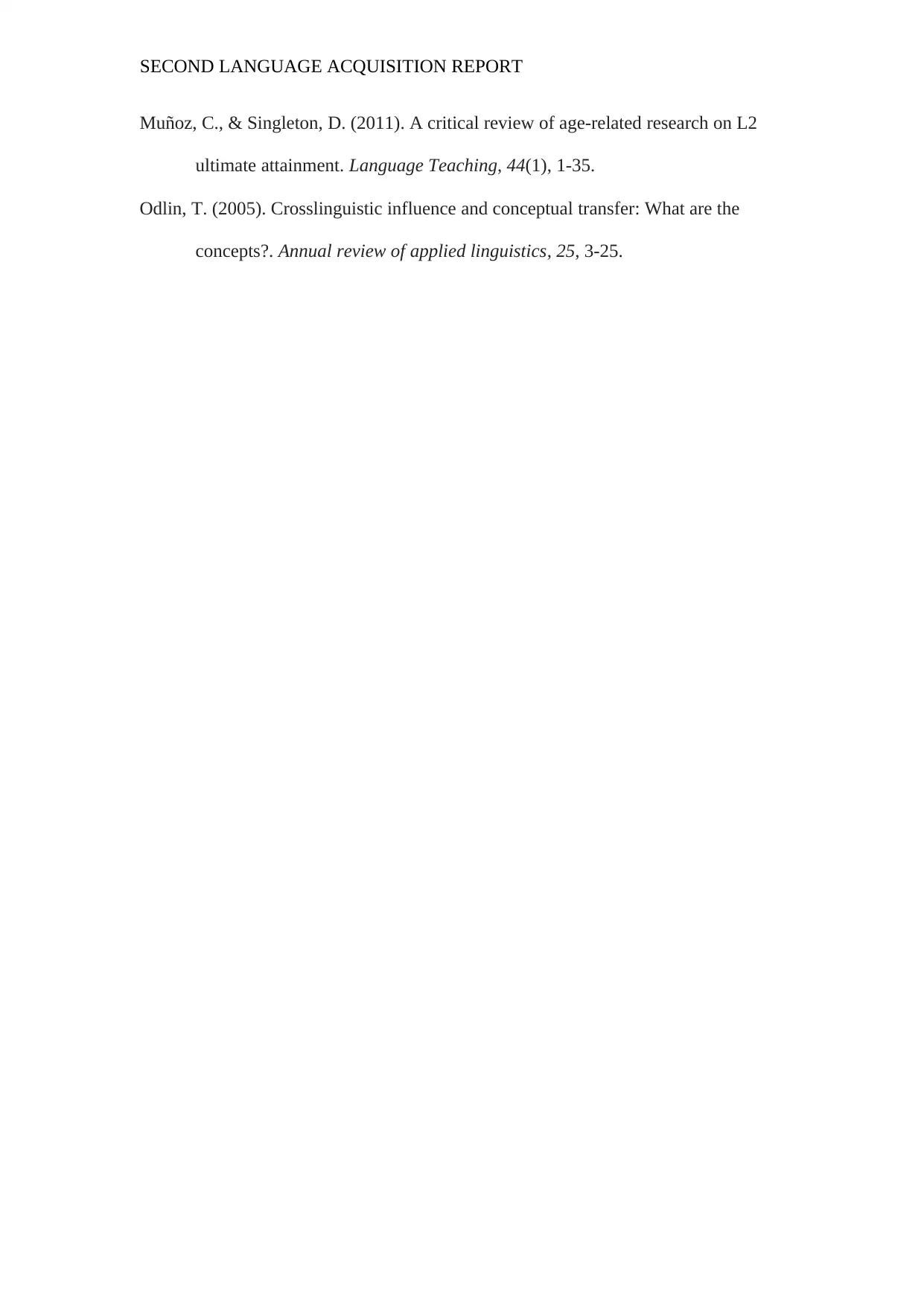
SECOND LANGUAGE ACQUISITION REPORT
Muñoz, C., & Singleton, D. (2011). A critical review of age-related research on L2
ultimate attainment. Language Teaching, 44(1), 1-35.
Odlin, T. (2005). Crosslinguistic influence and conceptual transfer: What are the
concepts?. Annual review of applied linguistics, 25, 3-25.
Muñoz, C., & Singleton, D. (2011). A critical review of age-related research on L2
ultimate attainment. Language Teaching, 44(1), 1-35.
Odlin, T. (2005). Crosslinguistic influence and conceptual transfer: What are the
concepts?. Annual review of applied linguistics, 25, 3-25.
⊘ This is a preview!⊘
Do you want full access?
Subscribe today to unlock all pages.

Trusted by 1+ million students worldwide
1 out of 14
Related Documents
Your All-in-One AI-Powered Toolkit for Academic Success.
+13062052269
info@desklib.com
Available 24*7 on WhatsApp / Email
![[object Object]](/_next/static/media/star-bottom.7253800d.svg)
Unlock your academic potential
Copyright © 2020–2025 A2Z Services. All Rights Reserved. Developed and managed by ZUCOL.





